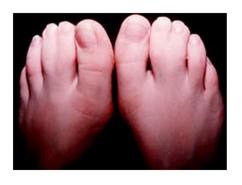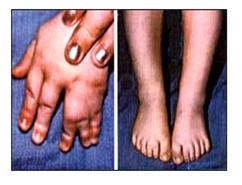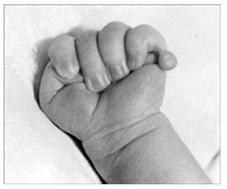손가락과 발가락의 다지증 및, 또는 합지증, Polydactyly and syndactyly of fingers and/or toes

사진 245.양쪽 발의 둘째와 셋째 발가락이 붙어 있는 합지증
출처: Mead Johnson Nutritionals, USA와 소아가정간호 백과

사진 246.다지와 합지가 함께 있는 다지증과 합지증.
출처: Mead Johnson Nutritionals, USA와 소아가정간호 백과
- 한쪽 손에 다섯 개 이상 손가락이 나 있거나 한쪽 발에 다섯 개 이상 발가락이 나 있는 선천성 손, 발 기형을 다지증(Polydactylism), 또는 지과잉증이라고 한다.
- 한 개의 손가락이 바로 옆에 있는 다른 손가락과 꼭 붙어있는 손가락 기형을 합지증이라 한다.
- 한 개의 발가락이 바로 옆에 있는 발가락과 서로 꼭 붙어 있는 발가락의 기형을 합지증 (Syndactyly), 또는 지유합증이라고 한다.
- 손가락과 발가락에 가장 흔히 생기는 선천성기형은 다지증이나 합지증, 또는 다지증과 합지증이 함께 생겨 있는 기형이다.
- 엄지손가락이나 새끼손가락에 손가락이 가외로 하나 더 나 있는 다지증도 있다.
- 발에 다지증이나 합지증이 생길 수 있다.
- 한 개의 발가락이 옆에 있는 다른 발가락과 서로 붙은 발가락 합지증은 좀 더 흔하다.
- 다지증이나 합지증은 상염색체 우성으로 유전된다.
- 발가락 합지증을 가진 아이의 부모 형제자매들 중 누구든지 발가락 합지증을 가지고 있는 때가 많다.
| 손가락 및, 또는 발가락의 다지증과 합지증의 치료 |

사진 247.대롱대롱 매달린 가외 손가락 기형 즉 손가락. 다지증이 있다.
CopyrightⒸ2011 John Sangwon Lee, MD., FAAP

사진248.손가락뼈가 있는 가외 손가락이 새끼손가락에 매달려 있다.
Used with permission from Schering Corporation Kenilworth, NJ 07033
- 다지나 합지의 정도에 따라 치료가 다르다.
- 사진 247에서 보는 바와 같이 정상 손가락에 가외 손가락이 대롱대롱 매달려있는 손가락 다지증이 있을 때 가외 손가락을 쉽게 떼 낼 수 있다.
- 가외로 난 손가락의 기시부가 가늘고 그 속에 뼈가 없을 때는 기시부를 실로 꼭 맨 후 2주 정도 되면 가외로 난 손가락 기형이 말라 자연히 떨어질 수 있다.
- 사진 248에서 볼 수 있는 것과 같이 가외로 난 손가락의 다지 기형 속에 뼈가 들어있을 수 있다.
- 그런 손가락 기형은 생후 적당한 시기에 선별적 수술로 제거한다.
- 다른 종류의 손의 다지증이나 합지증은 가능한 한 조기에 정형외과에서 진단을 받고 적절한 치료를 받아야 한다.
- 발의 다지증과 합지증도 정도에 따라 치료를 받는다.
- 사진 245에서 보는 것과 같이 경미한 발 합지증은 아무 치료를 하지 않고 관찰적 치료를 한다.
- [부모도 반의사가 되어야 한다- 소아가정간호 백과]-제 16권 소아청소년 정형외과 질환-다지증 참조.
Polydactyly and syndactyly of fingers and/or toes 손가락과 발가락의 다지증 및, 또는 합지증

Photo 245: polydactyly with the second and third toes of both feet attached. Source: Mead Johnson Nutritionals, USA and Encyclopedia of Pediatric Home Care.

Photo 246: polydactyly and syndactyly. Source: Mead Johnson Nutritionals, USA and Encyclopedia of Pediatric Home Care.
- Congenital hand and foot deformities with five or more fingers on one hand or five or more toes on one foot are called polydactyly.
- A finger malformation in which one finger is tightly attached to the other finger next to it is called limpid.
- A malformation of the toe with one toe right next to it and the toes that are tightly attached to each other is called
- The most common congenital anomalies on the fingers and toes are polydactyly and Syndactly
- There are also polydactyly, in which the thumb or little finger has an extra finger.
- Pods or limbs may develop on the feet. Toe limbs, in which one toe sticks to the other toe on the side are more common.
- polydactyly and Syndactly are inherited as autosomal dominant. Many of the parents, siblings, and siblings of a child with slit toe have a slit toe.
Treatment of polydactyly of fingers and or toes

Photo 247. Finger polydactyly malformationof finger.
CopyrightⒸ2011 John Sangwon Lee, MD., FAAP Picture

248: An extra finger with a finger bone is hanging from the little finger. Used with permission from Schering Corporation Kenilworth, NJ 07033 Treatment differs depending on the degree of tasting or lamination.
As shown in Photo 247, when there is a finger polydactyly in which the extra finger hangs from the normal finger, the extra finger can be easily removed.
If the origin of the extraneous finger is thin and there is no bone in it, the deformity of the extraneous finger may dry out and fall naturally after about 2 weeks after tightening the base with thread.
As shown in picture 248, there may be bones in the dodge deformities of the extraneous fingers.
Such finger anomalies are removed by selective surgery at an appropriate time after birth. Other types of dyspepsia or limbs of the hand should be diagnosed by orthopedic surgery as early as possible and treated appropriately.
Treatment depends on the degree of polydactyly and Syndactly of the foot.
As shown in picture 245, for mild limbs, observational treatment is performed without any treatment. [Parents should also be at least the half-doctors-Children and Family Nursing Encyclopedia]-Vol. 16 Pediatric and adolescent Orthopedic Diseases-See polydactyly and Syndactly
출처 및 참조 문헌 Sources and references
- NelsonTextbook of Pediatrics 22ND Ed
- The Harriet Lane Handbook 22ND Ed
- Growth and development of the children
- Red Book 32nd Ed 2021-2024
- Neonatal Resuscitation, American Academy Pediatrics
- www.drleepediatrics.com 제1권 소아청소년 응급 의료
- www.drleepediatrics.com 제2권 소아청소년 예방
- www.drleepediatrics.com 제3권 소아청소년 성장 발육 육아
- www.drleepediatrics.com 제4권 모유,모유수유, 이유
- www.drleepediatrics.com 제5권 인공영양, 우유, 이유식, 비타민, 미네랄, 단백질, 탄수화물, 지방
- www.drleepediatrics.com 제6권 신생아 성장 발육 육아 질병
- www.drleepediatrics.com제7권 소아청소년 감염병
- www.drleepediatrics.com제8권 소아청소년 호흡기 질환
- www.drleepediatrics.com제9권 소아청소년 소화기 질환
- www.drleepediatrics.com제10권. 소아청소년 신장 비뇨 생식기 질환
- www.drleepediatrics.com제11권. 소아청소년 심장 혈관계 질환
- www.drleepediatrics.com제12권. 소아청소년 신경 정신 질환, 행동 수면 문제
- www.drleepediatrics.com제13권. 소아청소년 혈액, 림프, 종양 질환
- www.drleepediatrics.com제14권. 소아청소년 내분비, 유전, 염색체, 대사, 희귀병
- www.drleepediatrics.com제15권. 소아청소년 알레르기, 자가 면역질환
- www.drleepediatrics.com제16권. 소아청소년 정형외과 질환
- www.drleepediatrics.com제17권. 소아청소년 피부 질환
- www.drleepediatrics.com제18권. 소아청소년 이비인후(귀 코 인두 후두) 질환
- www.drleepediatrics.com제19권. 소아청소년 안과 (눈)질환
- www.drleepediatrics.com 제20권 소아청소년 이 (치아)질환
- www.drleepediatrics.com 제21권 소아청소년 가정 학교 간호
- www.drleepediatrics.com 제22권 아들 딸 이렇게 사랑해 키우세요
- www.drleepediatrics.com 제23권 사춘기 아이들의 성장 발육 질병
- www.drleepediatrics.com 제24권 소아청소년 성교육
- www.drleepediatrics.com 제25권 임신, 분만, 출산, 신생아 돌보기
- Red book 29th-31st edition 2021
- Nelson Text Book of Pediatrics 19th- 21st Edition
- The Johns Hopkins Hospital, The Harriet Lane Handbook, 22nd edition
- 응급환자관리 정담미디어
- Pediatric Nutritional Handbook American Academy of Pediatrics
- 소아가정간호백과–부모도 반의사가 되어야 한다, 이상원 저
- The pregnancy Bible. By Joan stone, MD. Keith Eddleman, MD
- Neonatology Jeffrey J. Pomerance, C. Joan Richardson
- Preparation for Birth. Beverly Savage and Dianna Smith
- 임신에서 신생아 돌보기까지. 이상원
- Breastfeeding. by Ruth Lawrence and Robert Lawrence
- Sources and references on Growth, Development, Cares, and Diseases of Newborn Infants
- Emergency Medical Service for Children, By Ross Lab. May 1989. p.10
- Emergency care, Harvey Grant and Robert Murray
- Emergency Care Transportation of Sick and Injured American Academy of Orthopaedic Surgeons
- Emergency Pediatrics A Guide to Ambulatory Care, Roger M. Barkin, Peter Rosen
- Quick Reference To Pediatric Emergencies, Delmer J. Pascoe, M.D., Moses Grossman, M.D. with 26 contributors
- Neonatal resuscitation Ameican academy of pediatrics
- Pediatric Nutritional Handbook American Academy of Pediatrics
- Pediatric Resuscitation Pediatric Clinics of North America, Stephen M. Schexnayder, M.D.
-
Pediatric Critical Care, Pediatric Clinics of North America, James P. Orlowski, M.D.
-
Preparation for Birth. Beverly Savage and Dianna Smith
-
Infectious disease of children, Saul Krugman, Samuel L Katz, Ann A.
- 제4권 모유, 모유수유, 이유 참조문헌 및 출처
- 제5권 인공영양, 우유, 이유, 비타민, 단백질, 지방 탄수 화물 참조문헌 및 출처
- 제6권 신생아 성장발육 양호 질병 참조문헌 및 출처
- 소아과학 대한교과서
-
Copyright ⓒ 2014 John Sangwon Lee, MD., FAAP
“부모도 반의사가 되어야 한다”-내용은 여러분들의 의사로부터 얻은 정보와 진료를 대신할 수 없습니다.
“The information contained in this publication should not be used as a substitute for the medical care and advice of your doctor. There may be variations in treatment that your doctor may recommend based on individual facts and circumstances.
“Parental education is the best medicine.